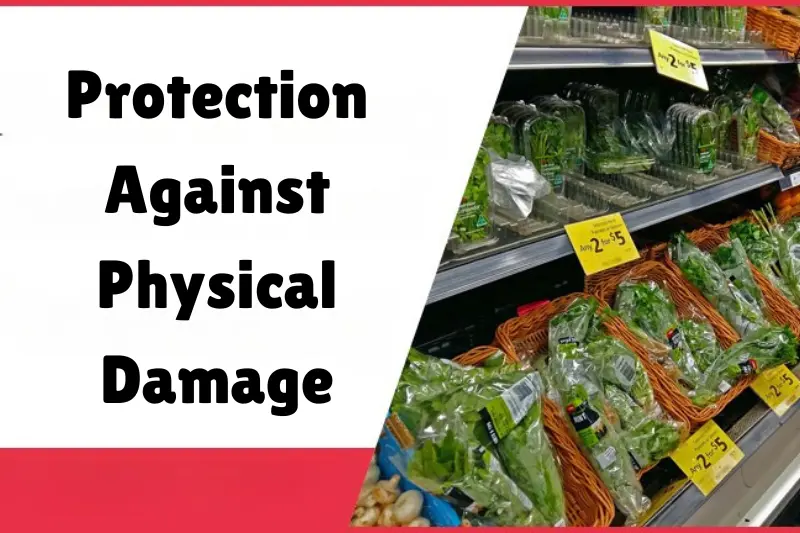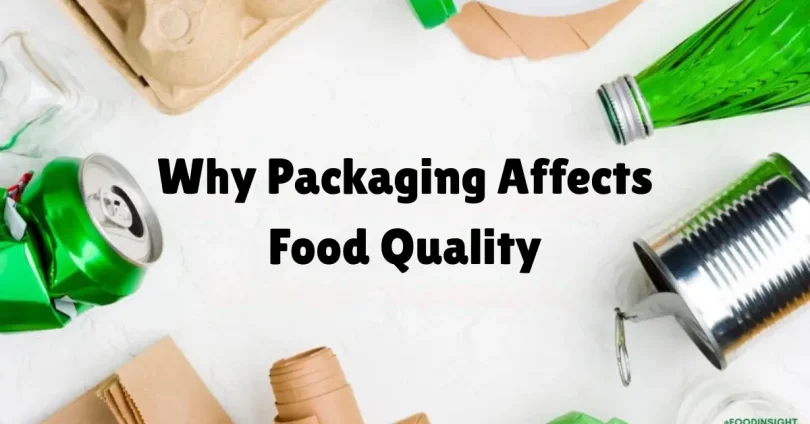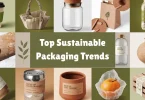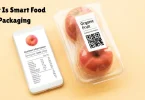Understanding why packaging affects food quality is essential in today’s fast-paced food industry. Packaging is not merely a marketing tool; it is a critical factor that ensures food safety, extends shelf life, and maintains nutritional value. Whether you are a manufacturer or a consumer, recognizing the role of packaging can help in making informed decisions about food storage, transportation, and consumption. Improper packaging can result in contamination, spoilage, loss of texture or flavor, and even health hazards. On the other hand, effective packaging protects food from environmental stress, physical damage, and microbial invasion, ensuring it reaches consumers in optimal condition.
In this guide, we will explore the multiple ways why packaging affects food quality and why it is a vital aspect of the food supply chain.
1. Protection Against Physical Damage

One of the primary reasons why packaging affects food quality is its ability to shield food from physical damage during storage, handling, and transportation. Many foods are fragile and easily affected by external forces. For example:
- Baked goods like cakes and cookies can crumble or break.
- Fruits and vegetables can bruise or lose freshness if handled roughly.
- Chips and snacks can crush, losing their shape and texture.
Types of protective packaging:
- Rigid packaging: Materials like cardboard boxes, hard plastic containers, or glass jars provide structural support and protect foods from crushing.
- Flexible packaging: Vacuum-sealed pouches or laminated bags offer cushioning and reduce movement, minimizing damage during transportation.
Impact on food quality: Physical damage can affect texture, appearance, and taste, making food less appealing and potentially unsafe to consume. Proper packaging ensures food arrives in its intended form.
2. Barrier Against Microbial Contamination
Food contamination by bacteria, fungi, or other microorganisms is a significant cause of spoilage. Packaging acts as a protective barrier to reduce exposure to pathogens.
- Sealed packaging such as vacuum packs, cans, or airtight jars prevents entry of oxygen, moisture, and dust, which are essential for microbial growth.
- Modified atmosphere packaging (MAP): By replacing oxygen with nitrogen or carbon dioxide, MAP slows microbial activity and extends shelf life for perishable items like meat, cheese, and fresh produce.
Impact on food quality: By limiting microbial contamination, packaging ensures food remains safe, fresh, and healthy for consumption, reducing the risk of foodborne illnesses.
You may also like to read this:
Why Clean Eating Is More Than A Trend | Complete Guide
Top Best Trending Snacks In The Market For Snack Lovers
Top Future Food Innovations To Watch For Smarter Eating
What Is Smart Food Packaging? Everything You Should Know
How Eco-Friendly Packaging Works: Complete Guide For 2025
10 Types of Packaging Used In Processed Foods Explained
3. Control of Moisture and Oxygen
Moisture and oxygen are two of the main factors that accelerate food spoilage. Effective packaging controls these elements to maintain food quality.
- Moisture-proof materials: Aluminum foil, laminated films, and plastic wraps prevent water from entering or leaving the package, protecting dry foods such as cereals, powders, and snacks.
- Oxygen-barrier packaging: Reduces exposure to oxygen, which can cause rancidity in nuts, oils, and fried foods.
Impact on food quality: Proper moisture and oxygen control ensures flavor, aroma, and texture are preserved, keeping food enjoyable and safe.
4. Protection Against Chemical Contamination
Food can interact with environmental chemicals or even with the packaging itself. These reactions can alter taste, color, and nutritional content.
- Food-grade plastics, metals, and glass are designed to prevent harmful chemicals from leaching into the food.
- Special coatings in cans and cartons prevent reactions with acidic foods, such as tomato sauces or citrus-based products.
Impact on food quality: Proper packaging prevents chemical contamination, preserving the natural taste, appearance, and nutritional value of the food.
5. Temperature Regulation
Many foods are sensitive to temperature fluctuations, which can negatively affect quality. Packaging helps in maintaining optimal storage conditions.
- Insulated packaging slows down temperature changes, especially during transportation of perishable goods.
- Frozen food packaging prevents freezer burn and protects frozen items from dehydration or ice crystal formation.
Impact on food quality: Temperature regulation helps preserve texture, flavor, and freshness, reducing spoilage and maintaining nutritional content.
6. Light Protection
Exposure to light, particularly UV light, can degrade food quality, causing nutrient loss, color changes, and off-flavors.
- Opaque or tinted containers block harmful light from reaching sensitive foods like milk, juices, and oils.
- Laminated films and multi-layered packaging provide additional protection against light-induced degradation.
Impact on food quality: Protecting foods from light helps maintain nutrients, flavor, and visual appeal, prolonging shelf life.
7. Convenience and Portion Control
Packaging also influences food quality indirectly through convenience and portion control.
- Resealable packaging prevents repeated exposure to air and moisture, keeping food fresh longer after opening.
- Portion-controlled packs allow consumers to use only what is needed, preventing leftover spoilage.
Impact on food quality: Convenient and portioned packaging ensures food stays fresh and retains its intended taste and texture over time.
8. Clear Storage Instructions

Packaging communicates important storage information to consumers. Misunderstanding or ignoring storage instructions can result in spoilage.
- Labels often specify conditions such as refrigeration, keeping dry, or avoiding sunlight.
- Correct storage ensures that temperature-sensitive or light-sensitive foods maintain their quality.
Impact on food quality: Clear instructions prevent improper handling, preserving freshness, flavor, and nutrition.
9. Sustainability and Its Role in Food Quality
Modern consumers are increasingly concerned about sustainability. Packaging choices not only affect environmental impact but can also influence food quality.
- Biodegradable and compostable materials are being used for products like salads, snacks, and beverages. These materials must be carefully designed to maintain barrier properties against moisture, oxygen, and light.
- Recyclable packaging can sometimes compromise food protection if recycled materials are not properly treated, potentially affecting food safety and freshness.
Impact on food quality: Sustainable packaging must balance eco-friendliness with protective qualities to ensure food remains fresh, safe, and nutritious.
10. Branding, Consumer Perception, and Food Experience
While functional protection is the primary goal, packaging also affects how consumers perceive food quality. Studies show that well-designed, intact packaging can enhance the perception of freshness, premium quality, and hygiene.
- Transparent packaging allows consumers to see the product, building trust.
- Branded packaging with proper seals reassures buyers about safety and quality.
Impact on food quality perception: Even if the food itself is unchanged, good packaging can enhance consumer confidence and satisfaction, indirectly influencing the overall food experience.
11. Technological Innovations in Packaging
Advancements in packaging technology are transforming the way food quality is preserved. Some of the latest innovations include:
- Active packaging: Incorporates oxygen absorbers, moisture regulators, or antimicrobial agents to actively maintain food quality.
- Smart packaging: Uses sensors or indicators to inform consumers about freshness, temperature changes, or spoilage.
- Edible packaging: Innovative materials made from natural ingredients that are safe to consume and help protect the food naturally.
Impact on food quality: These technologies extend shelf life, reduce spoilage, and provide additional safety measures, demonstrating why packaging plays a critical role in maintaining food quality.
12. Common Mistakes in Packaging That Affect Food Quality
Even with advanced packaging, mistakes can compromise food quality. Common errors include:
- Using non-food-grade materials that leach chemicals.
- Improper sealing that allows air or moisture inside.
- Packaging that does not consider temperature or light sensitivity.
- Over-reliance on attractive design without sufficient protective features.
Impact on food quality: These mistakes can lead to contamination, spoilage, and nutrient loss, reinforcing the importance of proper packaging design and selection.
13. Consumer Tips for Maintaining Food Quality Through Packaging
Consumers also play a role in preserving food quality after purchase:
- Always check the integrity of packaging before buying.
- Follow storage instructions on the label carefully.
- Use resealable or airtight containers if the original packaging is compromised.
- Keep perishable foods refrigerated or frozen as indicated.
Impact on food quality: Proper handling and storage by consumers ensure that food remains fresh and safe until consumption.
Conclusion
Understanding why packaging affects food quality is essential for ensuring food safety, freshness, and nutritional value. Effective packaging protects food from physical damage, microbial contamination, moisture, oxygen, chemicals, temperature fluctuations, and light exposure. It also provides convenience, portion control, and clear storage guidance for consumers.
For manufacturers, choosing the right packaging materials and methods is crucial for delivering high-quality food. For consumers, paying attention to packaging ensures that the food consumed is safe, fresh, and as intended. Ultimately, good packaging is the bridge between production and consumption, preserving the integrity and quality of food from factory to table.
FAQs
1. Why is food packaging important for maintaining quality?
Food packaging is essential because it protects products from physical damage, microbial contamination, moisture, oxygen, light, and chemical interactions. Proper packaging ensures the food remains safe, fresh, and nutritious from production to consumption.
2. How does packaging prevent microbial contamination?
Packaging acts as a barrier against bacteria, fungi, and other microorganisms by sealing food from air, dust, and moisture. Techniques like vacuum sealing and modified atmosphere packaging (MAP) further reduce microbial growth, extending shelf life.
3. Can packaging affect the nutritional value of food?
Yes. Poor packaging can expose food to light, oxygen, or chemicals that degrade nutrients. High-quality packaging preserves vitamins, minerals, and overall nutritional content, keeping the food safe and healthy to consume.
4. What types of packaging help control moisture and oxygen?
Materials like aluminum foil, laminated films, plastic wraps, and oxygen-barrier packaging prevent moisture absorption and limit oxygen exposure. These are particularly important for snacks, cereals, nuts, and oils.
5. How does temperature-sensitive packaging affect food quality?
Temperature-controlled packaging, such as insulated boxes or frozen food pouches, maintains optimal storage conditions. This prevents spoilage, preserves texture, and ensures the food retains its intended taste and nutritional value.




